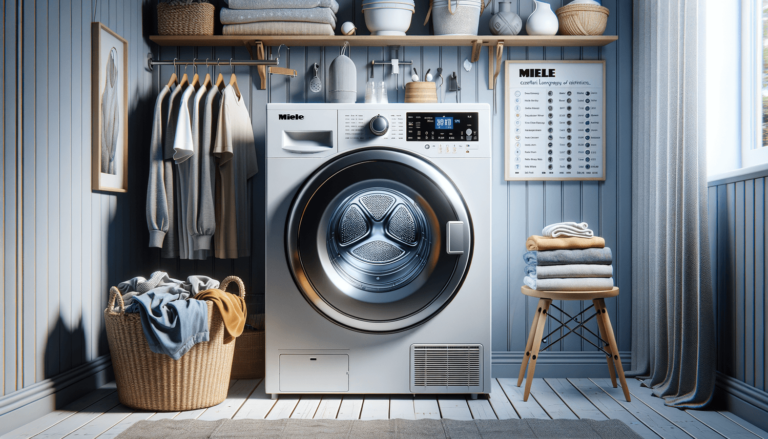

Introducing the ultimate guide on Miele Dryer Settings for all your laundry needs! Miele appliances are renowned for their high quality and durability, but getting the best out of them requires understanding the different drying options available. In this comprehensive blog post, we will delve into the various Miele Dryer Settings and when to use them, ensuring that your laundry comes out perfectly every time. Say goodbye to confusion and hello to perfectly dried garments with our Miele Dryer
The Miele Dryer comes equipped with settings tailored to specific fabric types, ensuring your garments receive the best care possible.
You can choose between different temperature levels on your Miele Dryer to cater to the specific requirements of your garments.
Miele Dryer Settings allow you to adjust the moisture levels of your finished laundry, which may be helpful for ironing or if you plan to store clothes for a longer period.
These settings can be used in conjunction with the above options to provide additional benefits that further refine the drying process.
Make the most of your Miele dryer by using the right settings for common laundry tasks. Here are a few examples of how to use these dryer settings for optimal results:
If you’re looking to save energy and contribute to a more sustainable environment, opt for the ‘Cottons’ program with the ‘Low Temperature’ setting. This combination provides efficient drying without overheating, making it one of the most eco-friendly settings available on your dryer.
To quickly dry large, bulky items such as bedding and towels, use the ‘Cottons’ program along with the ‘High Temperature’ setting. It speeds up the drying process for thick fabrics and ensures they come out fluffy and dry.
For delicate items, select the ‘Delicates’ program with the ‘Extra Low Temperature’ setting. This gentle combination preserves the quality and integrity of sensitive fabrics. For added care, enable the ‘Gentle Drum’ feature to minimize stress on your garments.
As a blog about technology settings, Settings King understands that getting the most from your appliances can be tricky. Here are some insider tips for your Miele dryer:
Regular maintenance and cleaning of the lint filter and heat exchanger helps ensure optimal performance and prevents fire hazards. Additionally, cleaning your dryer’s sensor will guarantee more accurate moisture level detection.
Sorting your laundry based on fabric type, weight, and color, will not only prevent damage to your clothing but also optimize the efficiency of your Miele dryer settings.
Resist the temptation to overload your dryer, as doing so reduces its efficiency and can lead to uneven drying. Giving your clothes enough space to tumble ensures that they dry properly and come out with minimal creasing.
Even with the best Miele Dryer Settings, you may encounter issues occasionally. Before calling for support, try these troubleshooting tips from Settings King:
If your clothes are still damp after a full cycle in the dryer, first make sure you’re using the appropriate program and temperature settings. Also, check the lint filter and clean it if necessary. Overloading or a blocked vent may also lead to inefficient drying.
A noisy Miele dryer can be caused by an imbalanced load or foreign objects in the drum. Ensure the clothes are spread evenly and make sure there are no coins, keys, or other small items in the drum. If the noise persists, it’s recommended to request a professional inspection.
If your Miele dryer is taking longer than usual to dry your laundry, ensure the right program, temperature, and moisture level settings are selected. Regular maintenance, such as cleaning the lint filter and heat exchanger, will also help maintain optimal drying times.
As a blog about technology settings, Settings King is committed to guiding you towards a stress-free laundry experience, and Miele Dryer Settings play a crucial role in that. Understanding and utilizing the diverse range of settings will ensure the longevity of your garments and the best possible care for your laundry.
With this comprehensive guide to Miele Dryer Settings, you can now optimize your drying process and enjoy wrinkle-free, perfectly dried clothes every time you unload your dryer. Happy drying!
After reading our comprehensive guide to Miele Dryer Settings, you may still have some questions. In this FAQ section, we address some of the most common inquiries related to this topic:
Yes, you can use fabric softener with your Miele dryer. Add fabric softener to your washing machine during the rinse cycle to improve the softness and feel of your garments. Miele dryers do not have fabric softener dispensers; the softener should be added during the washing process.
While Miele dryers do not have a dedicated setting for allergens, you can utilize the ‘Cottons’ program with the ‘High Temperature’ setting to effectively reduce allergens in your clothes. High temperatures help remove allergens such as dust mites, pet dander, and pollen from your laundry.
If your Miele dryer displays an error code, you can refer to the user manual for specific troubleshooting steps. Some error codes may require a simple fix, such as emptying the condensed water container or cleaning the lint filter, while more complex issues may need the attention of a professional technician.
Yes, you can stack your Miele dryer on top of a Miele washing machine using a Miele stacking kit. The kit is designed to securely connect the two appliances and save space in your laundry area. Ensure both appliances are compatible and follow the instructions provided in the stacking kit for safe installation.
Cleaning the Miele dryer sensor is essential for maintaining accurate moisture level detection. To clean the sensor, locate it near the lint filter and use a soft, dry cloth to gently wipe it clean. Do this regularly, along with cleaning the lint filter and heat exchanger, to ensure optimal dryer performance.